Using our joints is one of the keys to keeping them healthy, strong and mobile and simple range of motion exercises can be very effective. We all have normal ranges of joint movements and keeping those movements can help us manage pain and stiffness problems.
The knee joint, the largest of the body’s joints, is very strong and very stable. It has to cope with the demands of moving our weight about so needs that strength and stability. Knee pain is common but can be significantly helped by keeping the joint active and mobile.
Relaxation
First, a word about relaxation.
Our pain systems amplify their responses when we are tense or unrelaxed. This can get in the way of smooth movement of our joints. So, it’s worth looking at yourself in the mirror or having someone watch you as you move. Relaxation seems easy but is very hard to do well, and if you persist with practice, you will find it helps your pain and movements as well as your state of mind.
The Daily Practice
This idea often refers to meditation, exercise, good eating, work etc but here it just means doing the exercises regularly. The importance of keeping going, of practising regularly day after day, can’t be overstated.
Putting your knee through its full range of movement several times daily can help limit pain, increase the range and improve strength. It can reduce stiffness and stretch out all the tissues around the joint, allowing the knee to cope better with physical stresses.
Disclaimer
If you have any doubts about doing exercises for pain or stiffness or other condition, you should always consult a physiotherapist, other manual therapist or medical practitioner.
Exercises are definitely not a “one size fits all” situation, it is often important to get guidance individualised to your particular circumstances. These exercises shown here do not constitute medical advice and, in some cases, exercise can make your pain worse rather than better.
How to Do the Exercises
The exercises are very simple and not a magic solution to anything. If you keep them up over the days and weeks you will begin to see progress as your joint becomes less painful and more mobile.
If you have chronic (long-term) knee pain you may find that the exercises can maintain your movement but don’t change the pain much.
Start low by doing one set of five movements and do them slowly and in as relaxed and easy a fashion as you can. As you become more confident and your knee does not react, you can increase the numbers of sets, the numbers of movements and the times you do them every day. Three times a day, three sets of ten movements would be a good aim with time.
Quadriceps
This muscle, the name of which means “four heads” is the big muscle at the front of the thigh. It controls the knee and allows us to go up and down stairs, to get out of a chair and to walk and run. It’s not the only muscle that helps with this but it’s one of the most important.
Quads Tensing
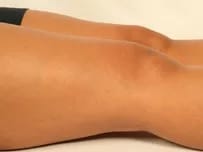
If you lie on a bed, sofa or the floor with your legs out in front of you, your quadriceps will be relaxed. It helps if the surface is firm rather than squashy. Tense up the muscle, gently pushing the knee down and you imagine raising your heel a little. Try and keep your buttock muscles relaxed and you should see the difference as the front of your thigh tenses up.
Inner Range Contraction
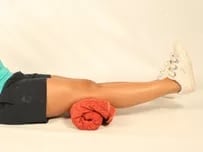
Sometime quads tensing is difficult and people can’t quite get the idea of doing it without tensing up the buttock madly. This exercise ensures the right muscle does the job.
Place a rolled-up towel or similar comfortable object under the knee. Tense the knee muscle and lift the heel until the leg is straight, without lifting the back of the knee off the roll. If you do this, the quadriceps have to be doing the work.
To make this easier, use a bigger roll, and you may not be able to get your knee up to completely straight when you start. Work at it and gradually reduce the height of the roll, which makes it harder.
Straight Leg Raise
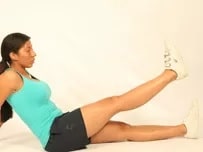
I’m not very keen on this exercise, which relies a lot on hip and abdominal muscles to maintain the position.
Lie with your leg out in front of you. Tense your quadriceps fully and then lift the straight leg up off the floor about six inches (15cm) and hold it there for five seconds or what time you can.
NB if you have a hip replacement on the same side DON’T do this exercise
Knee Bending
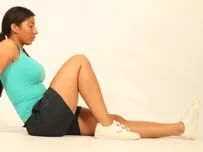
Called knee flexion by physios, this movement is very important in day to day life. For walking normally, we need around 70 degrees of bend. For going up and down stairs normally, we need 110 degrees.
It is more common to have problems with knee strength and straightening, but knee flexion is worth practising if you don’t have enough or have just had a total knee replacement.
Getting the knee to bend can be a little difficult if the quadriceps don’t relax well, so there are a few tricks to get your knee to bend. Starting with the easiest….
• Sit or lie with your leg out in front of you. Draw your heel up towards your bottom, allowing your knee to bend. You have to watch your heel as all the pressure of the weight of the leg is on it. Don’t get a pressure sore.
• Sit in a chair with your foot flat on the floor. A shiny floor like tiles or lino works best. Slide your knee into bend, hold for a second or two, then release.
• Sit on the edge of something higher, such as a bench or a table. Make sure it’s ok with your weight. With the leg hanging over the edge, it might be uncomfortable and be reluctant to go further than a certain amount. Put your good leg behind the affected heel area and pull down with the affected leg against the resistance of the good leg. This relaxes the quadriceps and can be very effective at getting the knee to relax into more bend.
• Do the same as the exercise above but pull against elastic resistance such as Theraband™
Prone Knee Bends
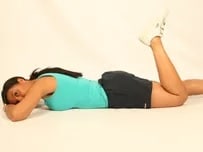
This is physio-speak for bending your knee while you are lying on your front. This is more difficult to do because it also involves flexibility of one of the hip muscles, which can be tight.
Lie on your front, bend your knee up as far as you can. You can also do this against the resistance of your other leg as in the previous exercise.
Remember – if you are uncertain in any way, get advice from your physio, manual therapist or medical practitioner.
Last Review Date: 05-02-2019
Next Review Date: 04-08-2020
